Welcome to the age of the cargo bike<p>As the need for cleaner, more sustainable transport becomes ever more urgent, I’ve noticed a familiar pattern in conversations on the topic. Someone will point out that bikes are a lot more efficient and environmentally friendly, reduce congestion and are often faster than cars in cities. Others respond saying that bikes can’t possibly replace cars for a multitude of reasons: Riding on roads is dangerous, it requires a fit body, it makes you get all sweaty, it’s not ideal for trips into the office and bikes can’t protect you from the rain. The other objection is that a standard bike can only carry one person, making it useless for the times when you need to carry multiple people, or lots of stuff. Bikes can’t be used to ferry kids on the school run or haul a week’s worth of groceries, and so it’s pointless to look at them.</p><p>Except, of course, bikes have
always been able to do those things, sometimes more efficiently than a car, SUV or truck. Cargo bikes offer the capacity to carry multiple people at once and / or haul sizable loads of stuff with very little trouble. It’s this form of cycling that may provide the easiest win for both individuals and cities to help solve the climate crisis. The argument that you need to be physically fit to ride – if that’s even true – doesn’t really apply any more given the benefit of electrification. It means that modern cargo bikes can rid dense city streets of delivery vans cluttering up our roads, and SUVs doing little more than the school run. And this isn’t a dispatch from some far-flung utopia, but something that might become massively popular as a looming fuel crisis causes the price of fuel to skyrocket.</p><span id="end-legacy-contents"></span><p><strong>The Bakfiets</strong></p><figure>
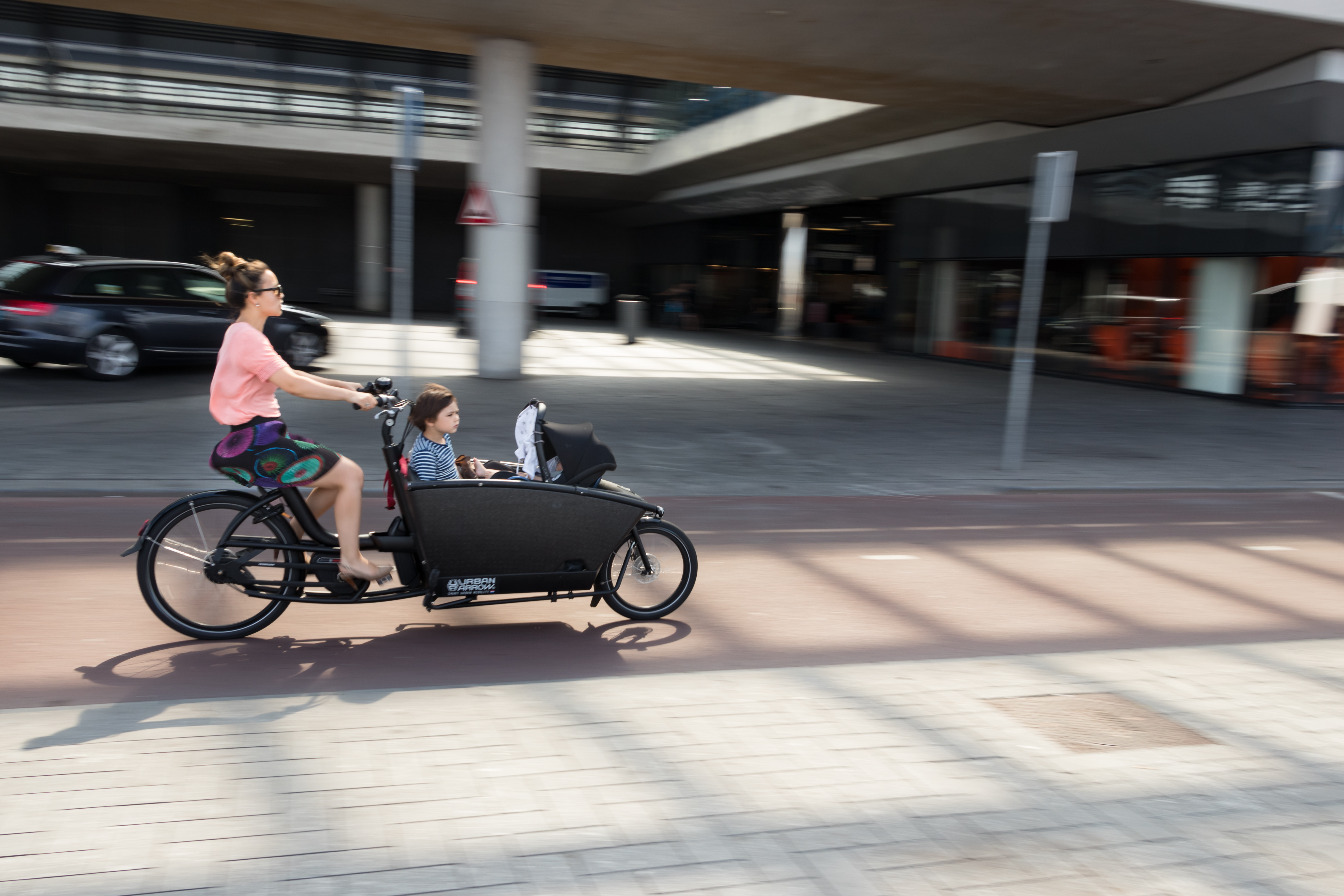
<figcaption></figcaption><div class="photo-credit">RUBEN RAMOS via Getty Images</div></figure><p>It’s worth saying that cargo bikes are nothing new – in the days before the car was king, cargo bikes were used by many. In Europe, before the second world war, cargo bikes were a common sight on the streets, used by grocers, tradespeople and families to carry goods and people. In the post-war era, and the age of car-centric reconstruction that followed, cargo bikes were left a curiosity in many countries, save, of course, their use to sell ice cream or other food at funfairs, festivals and markets.</p><p>There are roughly four types of cargo bike in common use today, although none of these terms are official and there’s plenty of blurring on the edges. Cargo Bikes, for instance, are stretch limousine versions of regular two-wheeled bikes, with a small cargo section behind the front wheel and in front of the rider. Then there are Box Trikes, with two wheels up front and a much larger box between them, while the rider steers from behind. Now, both of these can be described as Bakfiets, from the Dutch “box bike,” but there’s a world between the two and three-wheeled versions.</p><p>A more nebulous category is the Longtail, a regular bicycle with a longer, load-bearing frame behind the rider. Instead of a pannier rack, the frame can hold a small cargo box, or a bench seat that can hold an adult or two children. Bikes like
Tern’s GSD or
Yuba’s Spicy Curry are examples of the type of bike I’m talking about here. Finally there are Cargo Trikes and Cargo Quad Cycles, where the rider sits up front and there’s a hefty box mounted on the two rear wheels.
EAV’s 2Cubed, for instance, is already being adopted by some major logistics companies. (Obviously three-wheeled Bakfiets can also be called Cargo Trikes but I’m trying to keep the definitions clear here.)</p><p><strong>The Babboe</strong></p><figure>
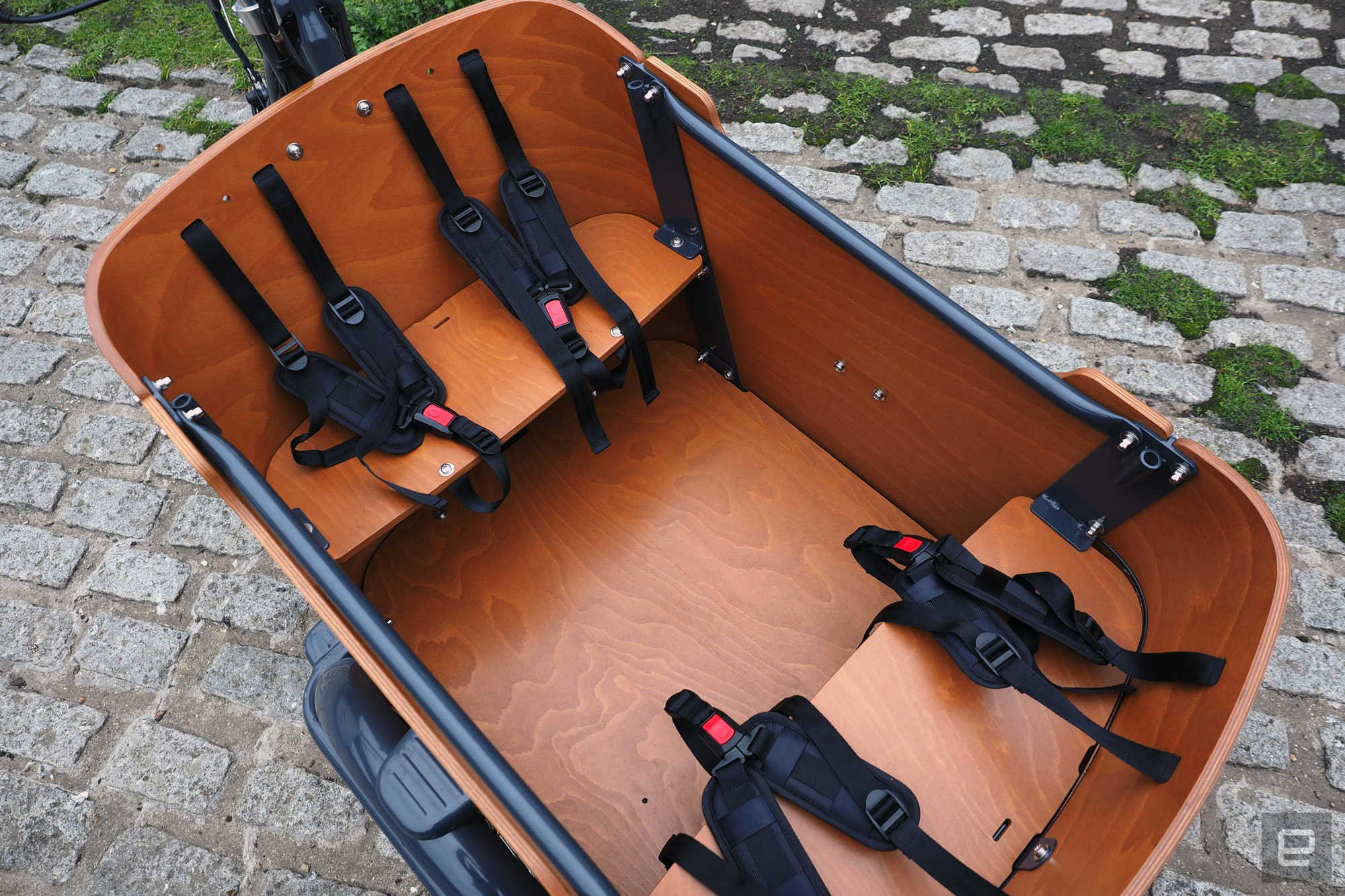
<figcaption></figcaption><div class="photo-credit">Daniel Cooper</div></figure><p>The Netherlands already underwent its dramatic transition into a cycling-first society, and is the nominal home of the cargo bike. Its bikes are designed not just for one or two people, but families of up to five, and I felt compelled to try one before lecturing people on the future of transport. Raleigh, the British distributors of several Dutch bicycles, leant me a
Babboe Curve-E, which is arguably the SUV of the cycling world.</p><p>The Curve-E is big, beefy and relatively expensive – in Europe it retails for €3,449 ($3,441). The Curve-E’s box has a volume of around 275 liters (72 gallons) and a load capacity of 100kg (220 pounds), with two benches running along the front and back sides. On each side are two three-point harnesses, and the bike is designed to carry up to four small children comfortably.</p><p>(In the US, you can buy a more powerful mid-drive version of the Curve-E I rode from
Going Dutch Bicycles in New York for $6,250. It’s worth saying, of course, that the cost of importing a model like this is significant, and there are domestic alternatives available for less. For instance, Bunch Bikes – which previously featured on
Shark Tank – will sell you a
four-seater model for $3,999.)</p><p>I’ve been using the Curve-E as much as I can in place of the family car, trying to see which parts of our lives it can fit into. My wife wasn’t enthused about being a participant in this story, and so I used the bike for various adventures with my two kids. Of particular interest to me was if the Babboe would revolutionize the school run, enabling me to save time at the start and end of each day.</p><p><strong>Cleaning up our roads</strong></p><figure>
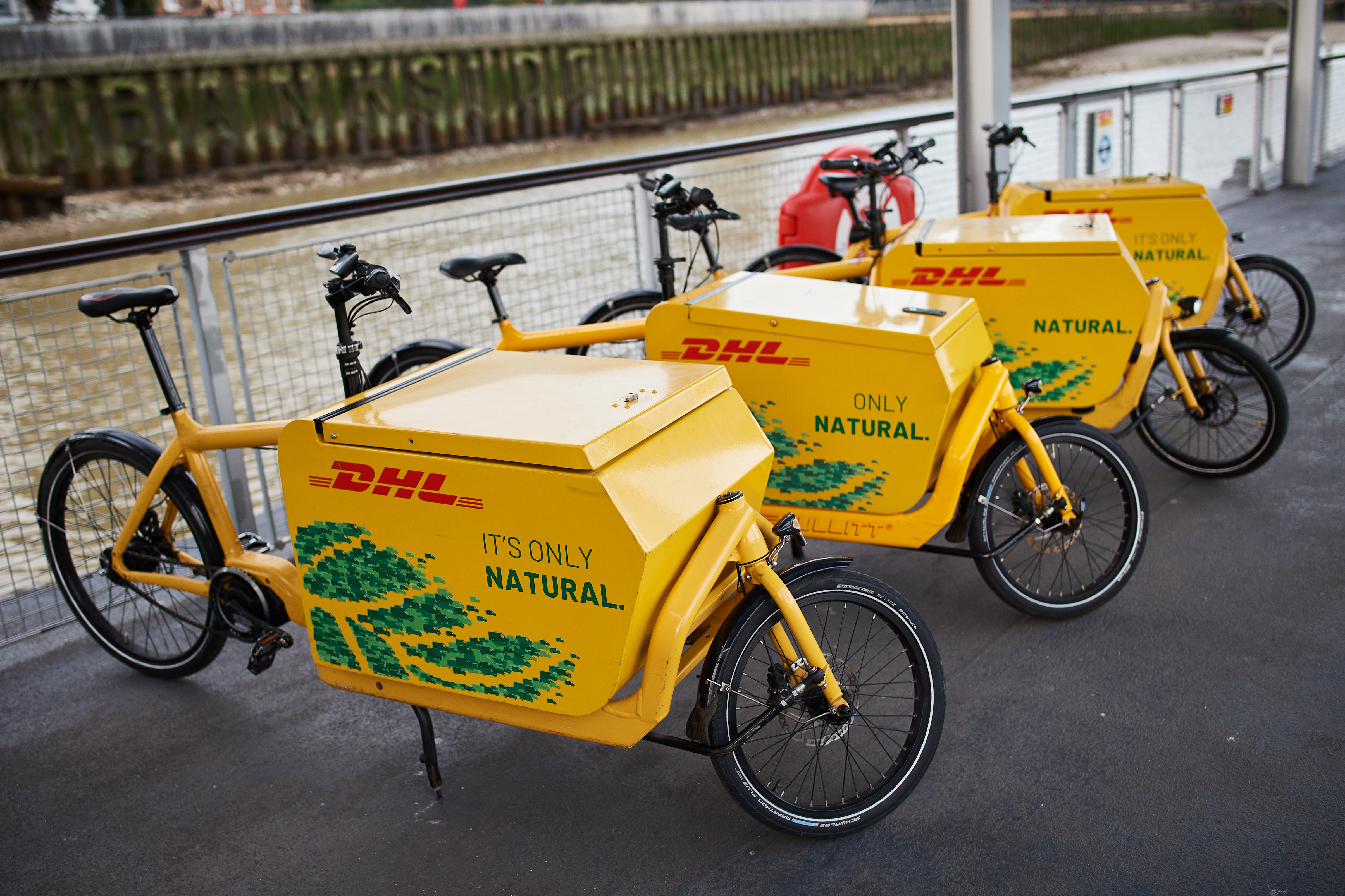
<figcaption></figcaption><div class="photo-credit">Leon Neal via Getty Images</div></figure><p>If you read Engadget, then you already know how bad cars and trucks are for climate change, air quality and congestion. The rise of e-commerce, supercharged by COVID, has seen a massive surge in fossil fuel-powered delivery vehicles on city streets. And that’s not good for congestion, air quality or emissions. But cargo cycling has already been found to be something of a silver bullet for all of the problems caused by this surge in heavy goods vehicles on our streets.</p><p>Last year, Dr. Ersilia Verlingheri at the
University of Westminster found that a cargo bike is 1.61 times faster than a van to make deliveries. Using GPS data strapped to both bike and truck couriers, she found that the bikes had a faster average speed and reduced carbon emissions by 90 percent compared to a diesel vehicle, and 33 percent compared to an electric van. The
study focused on London, and found that there are more than 213,100 vans working in the city, occupying 2,557,200 square meters of road space. Dr. Verlingheri’s study found that more than half of all motorized freight could be completed by a bike instead of a van. And that the benefits of doing so are staggering – including tens of thousands of hours lost to traffic jams, and several hundred thousand tonnes of CO2 not being released into the atmosphere.</p><p>A smaller
2019 study that focused on Seattle, found that electric-assisted cargo bikes were more cost-effective than vans in densely populated areas, such as the hearts of major cities. And that benefits of bikes were magnified when you added in the extra effort needed to find parking, and the second-order costs of owning a truck. Not to mention, of course, the cost of buying the truck, keeping it fueled, maintained, as well as the necessary insurances and permits to ensure it’s road legal.</p><p><strong>Zedify</strong></p><figure>

<figcaption></figcaption><div class="photo-credit">Daniel Cooper</div></figure><p>One company already well ahead of this argument is Zedify, a British courier business making “last mile” deliveries in major cities. It exclusively uses low-and-zero emission vehicles, with the bulk of its fleet made up with a number of cargo trikes. The managing director of the Norwich branch of the company, Richard Jennings, talked me through the benefits of a bike-first delivery fleet. The first being the cost, the second being the relative speed compared to deliveries made by a light truck.</p><p>Jennings explained that most major freight companies operate large depots at business parks far outside a population center. Each van is loaded full with parcels before being sent in to cover a planned route that will take the bulk of the day to complete. Zedify’s model, by contrast, uses a smaller hub in the center of a city, where parcels in bulk are dropped off and then loaded on a smaller fleet of cargo trikes. These trikes will then do multiple routes each day, with riders able to choose their own routing in order to avoid cyclist-unfriendly roads and dodge traffic jams.</p><p>On paper, that sounds
less efficient, but in practice Jennings said that it was significantly better, and Zedify deliveries are often a lot faster than expected. It’s also significantly cheaper, since all of the major capital costs associated with maintaining a fleet of vans are eliminated. The local setup, at least, uses cargo trikes from specialist provider
Iceni Cycles, based in Wiltshire. It sells its heavy-duty delivery trike for £11,705 (around $13,486), or leases them for periods of up to five years for £61.47 ($71) a week.</p><p>While many fleet companies have to spend enormous sums on regular maintenance, Jennings can employ a single bike mechanic to run the entire fleet. Zedify doesn’t charge a premium for its services either, meaning that any cost savings can be passed on to employees. Jennings said that he’s able to “take better care of [his] people.” Zedify also made (local)
headlines for being able to maintain deliveries during one of the UK’s several recent fuel crises.</p><p>There are limits, of course – a standard Iceni trike has a maximum weight limit of around 550 pounds, but Jennings says that the safe operating weight is just under 400. After that point, and hauling goods around just gets a lot harder to deal with. That means bicycle couriers won’t be delivering heavy goods, like home appliances or beds, any time soon. But the bulk of smaller goods could easily be carried by bike, removing a big reason for why city streets are full of vans. If companies like Zedify can corner the market in shipping and grocery delivery, then we should see significant benefits fairly quickly.</p><p>Jennings also showed me his latest purchase, a
Maderna Tractor, a four-wheeled monster capable of taking pallet-sized loads. It’s equipped with a Bafang mid-drive motor that gives it extraordinary power and speed for a bike – as I learned when I rode it. It’s the sort of bike that you could imagine riding for a day without ever feeling fatigued, and certainly one you could have a lot of fun tearing around town on.</p><p><strong>Our first trips</strong></p><p>My adventures with the Babboe Curve-E involved me taking the kids out and about around the city. They were (and still are) delirious with excitement whenever we go out on the bike. Part of this, I suspect, is because it offers them a substantially better view of the trip compared to sitting in the back seat of a car. They like waving to people as we pass them by, and shouting hello to cyclists when they, in turn, pass us. They sit side-by-side on the forward facing bench, preferring the view (and a little bit of a squeeze) to one facing the other.</p><p>At a standing start, the bike requires a decent amount of push, but I found I didn’t need the electric assist at all. As soon as you start moving, the bike’s weight and inertia seem to do a lot of the work for you, to the point where I was riding the brakes more than the pedals. It’s also pretty quick, quicker than I was comfortable riding (especially with my kids in the front box) and so I never felt the need to switch up the gears to go faster.</p><p>More often than not, cars would give me a fairly generous berth – I think the uniqueness of the Babboe’s design on British roads meant there was some degree of curiosity. Especially on the main road close to my home, where cyclists are often given short shrift by motorists, it was a striking change. I suspect, too, the fact that the bike is wide enough, and my ride position high enough, that almost by default, I was taking a more aggressive pose on the road than I would ordinarily. That’s important, given the lack of segregated cycle infrastructure, although cargo bikes are often forced onto the roads by default, as most cycle lanes that do exist are designed for the two-wheeled variety.</p><p><strong>The cargo boom</strong></p><p>It’s clear that some of the factors that have boosted interest in cargo bikes relate to the energy crisis. COVID and Russia’s invasion of Ukraine have caused prices to spike, and Europeans are looking for ways to cut their energy consumption across the board. Back in August,
Cycling Industry News reported that while e-bike sales – which had spiked for much of 2020 – were starting to slow, eCargo Bikes were still growing. In fact, the uptake of cargo bikes has increased by 37 percent compared to the previous year, while manufacturer Urban Arrow
said that it expected to see sales jump by 50 percent across 2022.</p><p><strong>The school run</strong></p><figure>
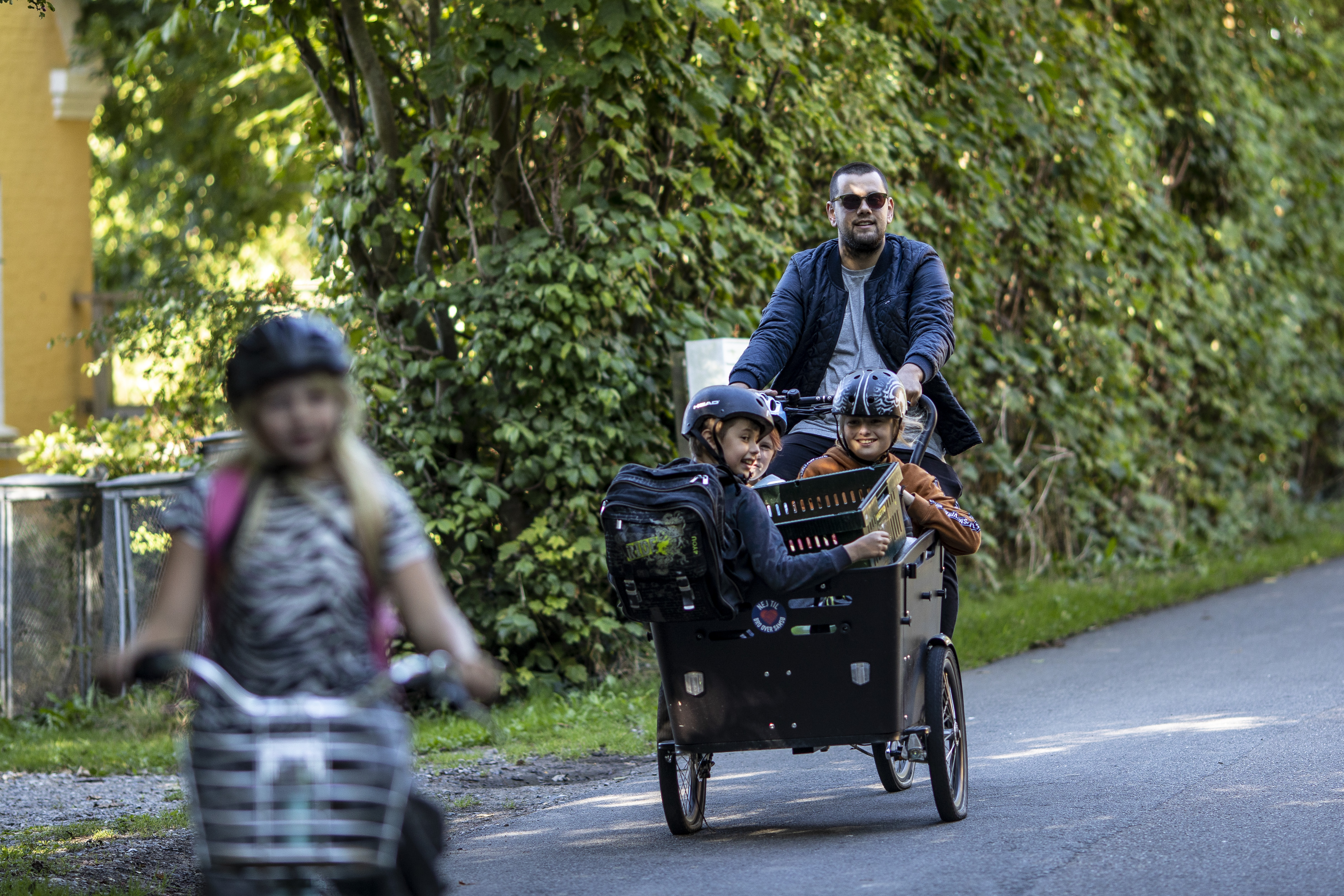
<figcaption></figcaption><div class="photo-credit">Maja Hitij via Getty Images</div></figure><p>The kids enjoy the Babboe so much that they ask, whenever we go out, if we’re taking it or the car. I was, therefore, expecting this bike to totally revolutionize the school run each day and make everyone’s life a lot easier. It didn’t, but there’s one very good reason that I struggled in this instance, and I want to be clear that it is actually worth doing. You just need to really make sure that you know what bike you’re buying, and what your home terrain is like.</p><p>My home city is relatively flat, but it does have a handful of utterly murderous hills, and my kids’ school is at the top of one of the worst. According to local maps, the gentlest gradient to get up the hill is around 11 percent, which is a very significant slope. (The road on the other end has a maximum gradient of 22.4 percent, which I wouldn’t attempt to
walk, let alone ride up.)</p><p>Now, I’ve tested my cycling output to be around 200W, and the motor on the Babboe can output 250W. But it turns out that it’s not enough, given the weight of the bike, to get up that 11 degree gradient without a lot of sweating. In fact, it’s so hard to get up there, especially with kids in the front, that no matter what gear I rode in, or what strategies I tried, with the electric assistance on full, I was still a hyperventilating puddle by the time I got to the top.</p><p>This, I should admit, is something that Babboe (if you check) does say in its marketing materials, as its bikes are designed for flat Dutch roads. If a buyer expects to cover a lot of hilly ground, then they should opt for the specialist Mountain version of its bike with a far more powerful mid-drive motor. At my child’s school, another parent bought the same model of Babboe that I had – but said that he would be trading it in for a Mountain version at the earliest opportunity.</p><p><strong>Cost</strong></p><figure>
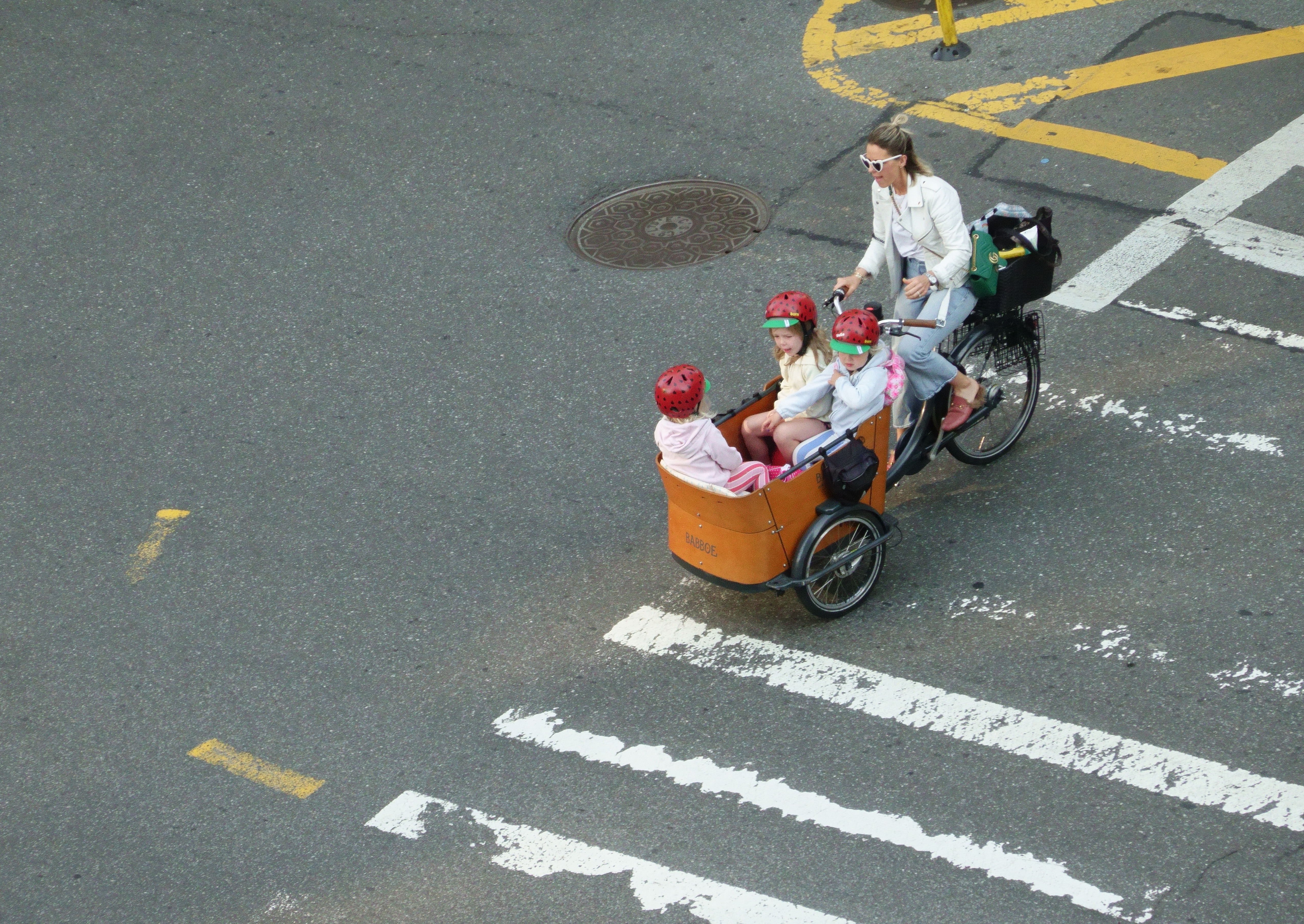
<figcaption></figcaption><div class="photo-credit">Education Images via Getty Images</div></figure><p>The elephant in the room is price. You can expect to pay upwards of $3,000 for a standard cargo cycle, and some of the fancier brands start at $5,000. The common response from cyclists is that people think nothing of dropping tens of thousands of dollars on a car, nor the hidden costs of fuel, tax, insurance, servicing and depreciation. On a total cost of ownership basis, the price difference between a car and a cargo bike is stark, and bikes win out nine times out of every 10 when picking the ideal form of transportation. But I can see, and share, the mental barriers to spending thousands on a bike for all of the obvious reasons.</p><p>For a start, the comfort level is far less than that of a car, you’re exposed to the elements and you’re limited by range. Then there’s the unspoken truth that in many countries in North America and Europe, bicycle theft is effectively legal. After all, with law enforcement resources stretched thin and the prevalence of bicycle crime, it’s difficult to enforce. Even in situations where people can show the location of their bike with built-in GPS, officers are reluctant to engage in recovery action.</p><div id="2cf10437433f48018ce2fabf7241b115"><blockquote class="twitter-tweet"><p lang="en" dir="ltr">Interesting (!) afternoon while filming, tracking my stolen bike which has an internal tracker & can’t be ridden without a code being ferried presumably in a van …from being swiped in London Bridge….To Stratford in half an hour and now finding a new resting place in East Ham…
pic.twitter.com/4SBsatjvA8</p>— Faisal Islam (@faisalislam)
August 3, 2022</div><p>I took plenty of extra precautions, and rarely let my Babboe out of my sight knowing that if I’d left it in the street, even with a chorus of locks, it was at risk. That dilemma is doubled for people who have spent upwards of $3,000 on an e-cargo bike as their primary mode of transportation. Sadly, a lack of infrastructure to keep these bikes safe and secure means that they’re a prime target for thieves, and so you can’t always trust that they’ll be where you left them.</p><p>The solution to this problem, surely, would be for a manufacturer to grasp this market for itself. Is it possible for someone to mass-produce a low-spec, but solid, cargo bike “for the people?” And, when I say that, I mean at the sort of prices where it’d be affordable for utility, rather than sport and leisure, cyclists.</p><p>Certainly, this isn’t likely to come in the form of a cargo trike. Ben Johnson is the founder of The Cargo Bike Company, a former engineer who got into cargo biking when his kids were born and he “couldn’t afford a European one.” He produces custom cargo bikes and trikes from his workshop in Derbyshire, UK, with a focus on commercial bikes as well as custom bikes adapted to assist people with mobility issues. He said that the rise in cargo cycling is tied to the falling cost and greater access of electric motors, which “enables people to shift loads around town.” He, however, has resisted the trend in his own bikes, saying that the reliability issues are too risky for a small business like his to take on.</p><p>Johnson added that there are several factors that mean that cargo bikes will remain a more costly purchase for many. That includes the fact that major manufacturers are “very happy to use unusual or high-end engineering” on its bikes, including drum brakes, geared hubs and stub axles. But as well as the equipment hung on the frame, a major difference between a regular bike and a cargo bike is the time taken to build the frame itself. For instance, Taiwanese maker Giant says that it can produce a bike frame in under two hours, whereas it takes Johnson a full day to weld a frame, and a further day to build the bike that sits on it – in between it’s sent off to a third-party for painting.</p><p>That’s not to say that there aren’t affordable cargo bikes available, but the segment that’s ripest for lower prices is the longtail.
RadPower’s RadWagon 4 can take a 350lb payload on its long rear rack, or that space could be used to carry two passengers for just $2,000. Similarly, Richard Andrews, who works in local government on cycling strategy in the UK said that an even more disruptive bike is hiding in plain sight. He pointed to (French sports retailer) Decathlon’s R500 electric longtail as a bike that could be mass-produced by the sort of manufacturer who could afford the initial outlay. There are only two downsides to the R500 – it uses a rear hub motor, and it’s
presently out of stock.</p><p><strong>Farewell</strong></p><p>It’s now time to send the Babboe back to the company for someone else to test it. I didn’t expect to feel as sad sending it back as I presently do, mostly because of how engaged it made my kids. It was fun to cycle – except up and down hills – and I think they enjoyed having a front-row seat on the journey, taking in the city around them. I think that, with a model better suited to the terrain, a cargo e-bike could remove the need for us to have a car for any trips into the city. The only thing I would need is a place to securely store it when I’m out and about, or the reassurance that it wouldn’t go missing.</p><p>I should, at least, have some hope there – here in the UK, the previous administration published Gear Change: A Bold Vision for Cycling and Walking. The paper committed to improving road design to ensure segregated cycleways – with a physical barrier between cars and bikes – would be built as standard. It also, more crucially, pledged to back the construction of high-quality, theft-deterrent bicycle parking in towns and cities, as well as bike hangers for residential areas. This should benefit folks who might want to switch to cargo cycling but don’t have the space to store a bike in their own home.</p><p>Fundamentally, I’m a convert, even if I still don’t consider myself a cyclist by any means. Riding a cargo bike feels natural, fun and easy, and is something I want to do on a regular basis, especially since I’d like to think my kids will still appreciate the help getting to and from places for the next five years or more. I think I learned two things over the last couple of months: Cargo cycling really is for everyone, and don’t buy a bike with a hub motor if you live anywhere close to a huge hill.</p>
Source:
Welcome to the age of the cargo bike